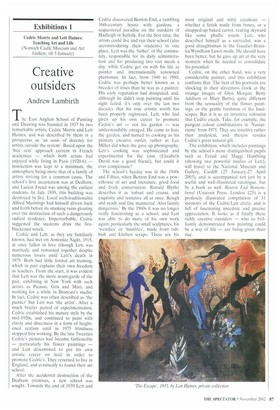Creative outsiders
Andrew Lambirth
The East Anglian School of Painting and Drawing was founded in 1937 by two remarkable artists, Cedric Morris and Lett Haines, and was described by them in a prospectus as 'an oasis of decency for artists outside the system'. Based upon the 'free rein approach current in French academies — which both artists had enjoyed while living in Paris (1920-6) — instruction was kept to a minimum, the atmosphere being more that of a family of artists striving for a common cause. The school's first incarnation was at Dedham, and Lucian Freud was among the earliest students. In July 1939, this building was destroyed by fire. Local arch-traditionalist Alfred Munnings had himself driven back and forth before its smoking ruins gloating over the destruction of such a dangerously radical tendency. Imperturbable, Cedric suggested the students draw the fireblackened wreck.
Cedric and Lett, as they are familiarly known, had met on Armistice Night, 1918, at once fallen in love (though Lett was married), and remained together despite numerous lovers until Lett's death in 1978. Both had little formal art training, which in part explains their own freedom as teachers. From the start, it was evident that Lett was the more avant-garde of the pair, exhibiting in New York with such artists as Picasso, Gris and Miro, and working for a while in Brancusi's studio. In fact, Cedric was often described as 'the painter' but Lett was 'the artist'. After a much briefer period of experimentation. Cedric established his mature style by the mid-1920s, and continued to paint with clarity and directness in a form of heightened realism until in 1975 blindness stopped him working. By the late Twenties Cedric's pictures had became fashionable — particularly his flower paintings — and Lett determined to put his own artistic career on hold in order to promote Cedric's. They returned to live in England, and eventually to found their art school.
After the accidental destruction of the Dedham premises, a new school was sought. Towards the end of 1939 Lett and Cedric discovered Benton End, a rambling 16th-century house with gardens, a sequestered paradise on the outskirts of Hadleigh in Suffolk. For the first time, the artists could live and run their school (also accommodating their students) in one place. Lett was the 'father' of the community, responsible for its daily administration and for producing two vast meals a day, while Cedric got on with his life as painter and internationally renowned plantsman. In fact, from 1940 to 1980. Cedric was perhaps better known as a breeder of irises than he was as a painter. His early reputation had dissipated, and, although he didn't stop painting until his sight failed. it's only over the last two decades that his true artistic worth has been properly registered. Lett, who had given up his own career to promote Cedric's art — not his garden — was understandably enraged. He came to hate the garden. and turned to cooking as his primary creative outlet, rather as Lee Miller did when she gave up photography. Lett's cooking was sophisticated and experimental for the time (Elizabeth David was a good friend), but could it ever compensate?
The school's heyday was in the 1940s and Fifties, when Benton End was a powerhouse of art and literature, good food and lively conversation. Ronald Blythe describes it as 'robust and coarse, and exquisite and tentative all at once. Rough and ready and fine mannered. Also faintly dangerous.' By the 1960s it was no longer really functioning as a school, and Lett was able to do more of his own work again, particularly the small sculptures, his 'w-eirdies' or 'humbles', made from rubbish and kitchen scraps. These are his
most original and witty creations — whether a fetish made from bones, or a strapped-up baked carrot, rearing skyward like some phallic totem. Lett, who described himself as a surrealist, was a good draughtsman in the Gaudier-Brzeska/Wyndham Lewis mode, He should have been better, but he gave up art at the very moment when he needed to consolidate his potential.
Cedric, on the other hand, was a very considerable painter, and this exhibition confirms that. The best of his portraits are shocking in their directness (look at the strange images of Glyn Morgan, Betty Addison or Mary Butts), quite different from the sensuality of the flower paintings, or the gentle freshness of the landscapes. But it is as an inventive colourist that Cedric excels. Take, for example, the pungent colour combinations in 'Nasturtiums' from 1975. They are intuitive rather than analytical, and therein resides Cedric's great natural gift.
The exhibition, which includes paintings by the school's more distinguished pupils such as Freud and Maggi Hambling (showing two powerful studies of Lett), will travel to the National Museum and Gallery, Cardiff (25 January-27 April 2003), and is accompanied not just by a useful and well-illustrated catalogue, but by a book as well. Benton End Remembered (Unicorn Press, London £25) is a profusely illustrated compilation of 31 memoirs of the Cedric/Lett circle, and is full of fascinating anecdote and precise appreciation. It looks as if finally these richly creative outsiders — who so brilliantly demonstrated how painting could be a way of life — are being given their due.


















































































































 Previous page
Previous page